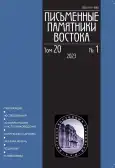“The Diamond Needle”: The Buddhist Roots of a Brāhmaṇic Text
- Authors: Burmistrov S.L.1
-
Affiliations:
- Institute of Oriental Manuscripts RAS
- Issue: Vol 20, No 1 (2023)
- Pages: 27-34
- Section: Research works
- Published: 03.05.2023
- URL: https://journals.eco-vector.com/1811-8062/article/view/205531
- DOI: https://doi.org/10.55512/WMO205531
- ID: 205531
Cite item
Full Text
Abstract
The similarity between the contents of the “Vajrasūcika-upaniṣad” and the “Āpta-vajrasūcī-upaniṣad” (both ascribed to Śaṃkara, 9th century) and that of the “Vajrasūcī” (ascribed to the Buddhist thinker Aśvaghoṣa, 2nd century) demonstrates that the dividing line between the Buddhist and Brāhmaṇic written cultures were not entirely impermeable. These texts describe what makes one a true brāhmaṇa. Aśvaghoṣa’s authorship of the “Vajrasūcī” is proved by three facts: (1) tradition unambiguously ascribing its authorship to him, (2) the worship formula in the maṅgala-śloka is addressed to Bodhisattva Mañjuśrī and (3) some stylistic features bring this treatise together with the style of early Mahāyāna texts (Madhyamaka school). At the same time, the treatise is composed within pure Brāhmaṇic conceptual field, it contains neither mentions nor allusions to Buddhist notions, but its main thesis is that the concept of brahminhood is internally contradictory. Besides, different authoritative texts give conflicting expositions of qualities that make one a brāhmaṇa. Nevertheless, this text was accepted by Brāhmaṇic school of Advaita Vedānta and ascribed to Śaṃkara, and its main thesis was reformulated as the idea that it is only knowledge of Ātman that makes one a true brāhmaṇa.
About the authors
Sergey L. Burmistrov
Institute of Oriental Manuscripts RAS
Author for correspondence.
Email: SLBurmistrov@yandex.ru
ORCID iD: 0000-0002-5455-9788
http://www.orientalstudies.ru/eng/index.php?option=com_personalities&Itemid=74&person=671
Dr. Sci. (Philosophy), Leading Researcher, Section of South Asian Studies of the Department of Central and South Asian Studies
Russian Federation, St. PetersburgReferences
- “ ‘Āpta-Vajrasūcī-Upaniṣad’ (A Complete Upaniṣad of the Diamond Needle). Introd., translit., transl. from Sanskrit into Russian and comment. by S.L. Burmistrov”. Pis’mennye pamiatniki Vostoka, 2013, vol. 1, no. 18, pp. 65–78 (in Russian).
- Basham, Arthur L. History and Doctrines of the Ājīvikas: A Vanished Indian Religion. Delhi–Varanasi–Patna: Motilal Banarsidass, 1981 (in English).
- Burmistrov, Sergei L. “Sekty i techeniia induizma v ‘Āpta-Vajrasūcī-Upanishade’ ” [Sects and Trends of Hinduism in the Āpta-Vajrasūcī-Upaniṣad]. Izvestiia Rossiiskogo gosudarstvennogo pedagogicheskogo universiteta imeni A.I. Gertsena, 2014, vol. 12, pp. 45–55 (in Russian).
- Korneyeva, Natalia A. “Introduction”. In: Viṣṇu-smṛti. Transl. from Sanskrit, introd., comment. and appendices by. N.A. Korneyeva Moscow: Vostochnaya literatura, 2007 (Pamiatniki pis’mennosti Vostoka, CXXXII), pp. 14–72 (in Russian).
- Shokhin, Vladimir K. Brahmanistskaya filosofiia: Nachal’nyi i ranneklassicheskii periody [Brāhmaṇist Philosophy: Initial and Early Classical Periods]. Moscow: Vostochnaya literatura, 1994 (in Russian).
- Shokhin, Vladimir K. Shkoly indiiskoi filosofii: Period formirovaniia (IV v. do n.e. — II v. n.e.) [Schools of Indian Philosophy: The Formation Period, 4th Century B.C. — 2nd Century A.D.]. Moscow: Vostochnaya literatura, 2004 (in Russian).
- “Vajra Suchi by Asvaghosha”. Transl. by B.H. Hodgson. In: Transactions of the Royal Asiatic Society of Great Britain and Ireland, 1835, vol. III, pp. 160–169 (in English).
- “The Vajrasuci of Asvaghosa”. Critically edited with notes and translations by S.K. Mukherjee. In: Visva-Bharati Annals, 1949, vol. II, pp. 133–184 (in English).
- “Vajrasūcika-upaniṣad”. In: Upaniṣady. Transl. into Russian, introd., comment., and Appendix by A.Ia. Syrkin. 2nd ed. Moscow: Vostochnaya literatura, 2000 (in Russian).
- Viṣṇu-smṛti. Transl. from Sanskrit, introd., comment. and appendices by. N.A. Korneyeva Moscow: Vostochnaya literatura, 2007 (Pamiatniki pis’mennosti Vostoka, CXXXII) (in Russian).
Supplementary files








